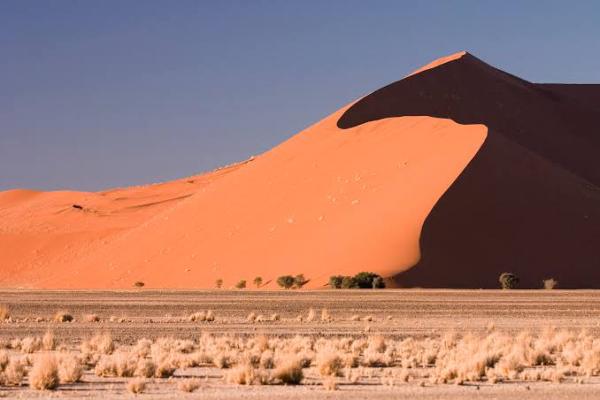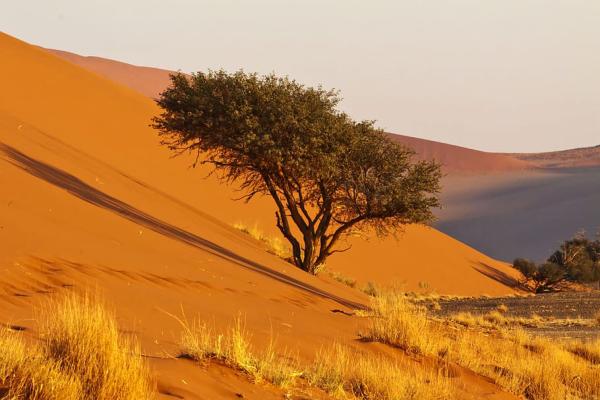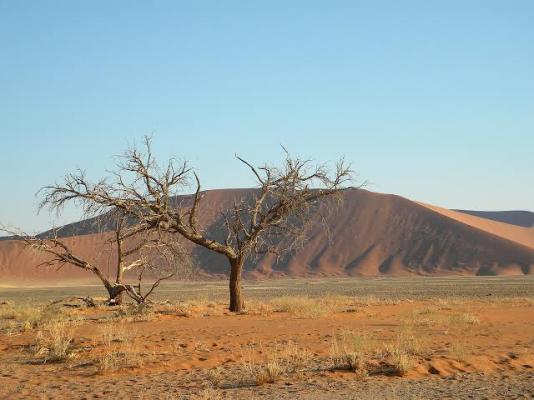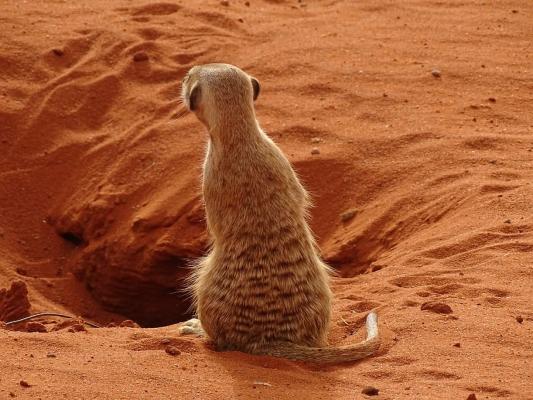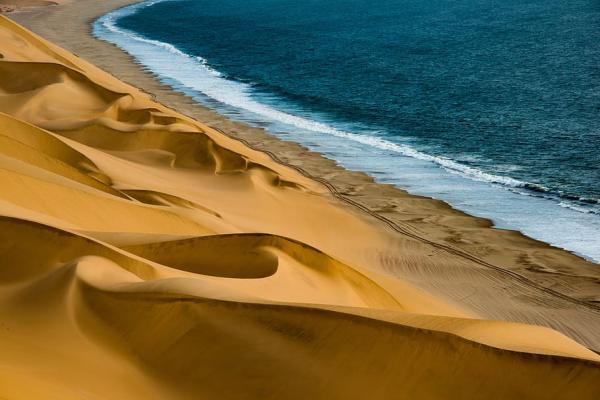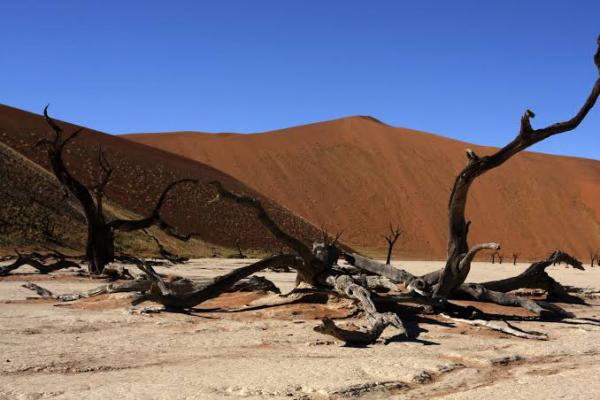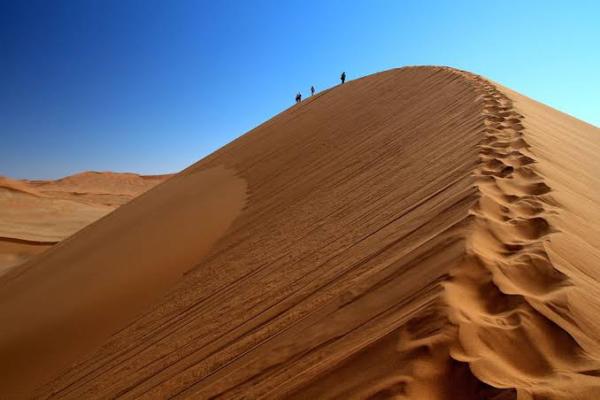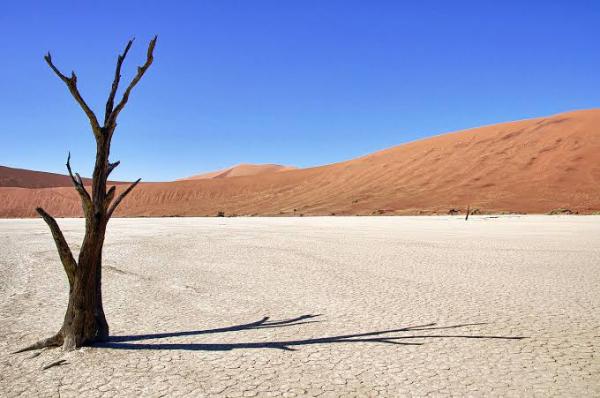Home | Wildlife & Game Reserves of Namibia | Namibia Tours & Safaris
Namibia, an arid country of surprising contrasts, is home to two great deserts. Along its length, the vast shifting sand sea of the Namib sprawls inland along the Atlantic coastline. In the interior, the plateau slopes away to the north and east to meet the Kalahari Desert. Over the years, there have been a number of cultural influences that have all added to the unique atmosphere of Namibia. At various times Germany, Great Britain and South Africa have all governed the territory, but it was with the eventual independence of Namibia in 1990 that the country was able to develop its multi-cultural character and reinvent itself.
Things to look forward to in Namibia:
- Climbing the worlds tallest sand dunes at Sossusvlei
- Viewing wildlife that has adapted to the harsh desert
- Tracking black rhino on foot in true wilderness
- Appreciating one of the oldest Bushman rock art sites in the world
- Interacting with the fascinating Himba people
Visitors information provides visitors to Namibia information on entry requiremants, climate, what to pack, credit cards & banking, driving, health & medical facilities and other related aspects:
Entry Requirements:
A valid passport is required to enter Namibia.
The Namibia Tourism Board has announced that border crossing fees have increased. The new fees are as follows as of 2017
- R177 for motor cycles, motor tricycles, motor quadru-cycles, caravans and light trailers
- R277 for motor cars, single and double-cab vehicles, 2x4 and 4x4 vehicles and minibuses (fewer than 25 passengers)
- R579 for light goods vehicles and delivery vehicles (GVM
Visitors to Africa must have a passport that is valid for at least 6 months beyond your intended departure date, together with onward travel documents, proof of accommodation and sufficient funds for the duration of your stay. Please also ensure that you have sufficient blank visa pages, not endorsement pages, in your passport, with at least 2 consecutive/side by side blank pages. Our recommendation is 3 pages, or even 4 if you are travelling through more than one country on your journey.
NOTE: All passengers under 18 years of age will need to present an unabridged birth certificate as well as a valid passport when entering, departing or transiting South Africa and Botswana. A sworn translation (certified/authenticated) in English should accompany all documentation that is in a language other than English.
For single parents, or those travelling alone with their child/ren, the following must be provided:
- An affidavit (no more than 3 months old on the date of travel) in which the absent parent gives consent for the child to travel, or
- A court order granting full responsibilities or legal guardianship of the child, or
- The death certificate of the absent parent.
Please speak to your Africa specialist to ensure that you have any appropriate travel documentation before departing on safari.
Climate:
The climate is typically semi-desert with hot days and cool nights. Midsummer temperatures may rise to over 40 degrees Celsius. Winter days are warm, but dawn temperatures may drop to freezing. Along the coast it is cool with low rainfall and fog prevails from late afternoon until mid-morning.
The rainy season lasts from October to April. The rest of the year is dry and cloudless. Namibia averages 300 days of sunshine a year.
What to pack:
- Sunblock, sun hat and good quality sunglasses
- Camera with waterproof/dustproof bag/cover
- Good walking shoes (tennis shoes are fine)
- Malaria tablets (if applicable)
- Warm Anorak or Parka and scarf / gloves for winter
Border posts:
For all cars (hired and private), a police clearance, vehicle licensing papers, insurance letter and an owner's proxy are required to enter Zambia, Botswana, Zimbabwe or Angola from Namibia.
Credit Cards:
International cards are widely accepted throughout the country, including most Government rest camps, hotels, shops and restaurants.
MasterCard and Visa are usually accepted throughout Namibia, but Diners Club and American Express are not. The currency is the Namibian Dollar (NAD) which is fixed to and therefore equivalent to the South African Rand (ZAR).
Currency:
Namibia banks, only accept US Dollars, GBP Sterling, Euro and South African Rand in cash. Travelers Cheques in any of the above currencies are also acceptable. The currency is the Namibian Dollar (NAD) which is fixed to and therefore equivalent to the South African Rand (ZAR).
Drinking Water:
In most of the country tap water is drinkable. Bottled mineral water and ice cubes are available at most shops and service stations. Always take several bottles of water along if you travel longer distances.
Getting to Namibia:
AirportsMain airport is Hosea Kutako International Airport 40km (25 miles) from Windhoek.
Other airports at Eros (Windhoek), Katima Mulilo, Rundu, Ondangwa, Walvis Bay, Luderitz, Keetmanshoop & 16 licensed air strips.
Transport available between airport and city.
By AirGetting into Namibia is generally by air into Hosea Kutako International Airport just outside Windhoek. Aside from being the main access point to the wilderness areas, Windhoek is also our national operational base and the hub for Wilderness Air, our own bush airline.
By Land:Generally, one can self-drive into Namibia and to all our camps, however distances are great and therefore we do recommend visiting our camps by air.
Driving Tips:
In Namibia driving is on the left side of the road. The roads are in a good condition - be it a gravel, tarmac or salt road. Avoid driving at night, as game may be crossing the road. Take great care to stick to the following speed limits:
Within cities and towns: 60km/h
On tarmac roads in rural areas: 120 km/h (Take care when travelling in northern Namibia as domestic animals often cross the roads).
On gravel roads it is advisable not to exceed 70 km/h due to the loose surface.
Fuel:
In every big town fuel is available. Refuel at every possible opportunity as remote areas can sometimes run out of fuel. Only cash is accepted at fuel stations. Most fuel stations do have unleaded fuel. Fuel prices vary from region to region.
Electrical Appliances:
All run on 220/240 volts. Outlets are of the round 3-pin, 15 amp types.
Health:
No inoculations are necessary. Should you enter from a country in which yellowfever prevails, you should have proof that you were vaccinated against this disease. Malaria-prophylaxis is recommended if you travel to norhtern Namibia during summer. Prophylaxis can also be bought without prescription from pharmacies in Namibia.
Language:
The official language is English and all documents, notices and directional signs are in this language. German and Afrikaans are also used throughout the country and there are numerous African languages and dialects which fall into two main groups: Bantu and Khoisan.
Medical:
By virtue of Namibia's vast size and the remoteness of many venues, high costs are involved when illness or accidents occur. Travel insurance covering baggage and valuables plus accident should be considered before departure.
Health:
Yellow fever vaccinations for people coming from affected countries.
Malaria vaccinations for people going to affected places in Namibia.
Inoculations regulations can change at short notice please check with embassies.
The country has good private and public medical and health facilities.
Time:
Summer: 1st Sunday in Sep - 1st Sunday in Apr: +2 hrs GMT
Winter: 1st Sunday in Apr - 1st Sunday in Sep: +1 hrs GMT
Safety and security:
Namibia is a safe destination. However, many Namibians own only a fraction of what a tourist owns. Therefore keep an eye on your belongings. Do not display expensive jewellery, cameras, cellphones or cash - rather lock your valuables in your hotel safe. Even if you park in an area where car guards look after vehicles, it is wise not to leave valuables in view.
